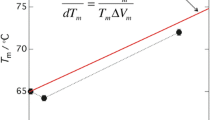Abstract
We have studied the lamellar-level morphology of poly(ethylene terephthalate) (PET)/polycarbonate (PC) blends using small-angle X-ray scattering (SAXS). Measurements were made as a function of the holding time in the melt. We determined the morphological parameters at the lamellar level by correlation function analysis of the SAXS data. An increased amorphous layer thickness was identified in the blend, indicating that some PC was incorporated into the interlamellar regions of PET during crystallization. The blend also exhibits a larger lamellar crystalline thickness (l c ) than that of pure PET. A possible reason for the increase inl c is that the inclusion of the PC molecules in the interlamellar regions causes an increase in the surface free energy of folding. At the early stage of isothermal crystallization, we observed a rapid drop in the value ofl c in the blend; this finding indicates that a relatively large fraction of secondary crystals form during the primary crystallization. In contrast, the value ofl c for the sample that underwent a prolonged holding time increased with time in the secondary crystallization-dominant regime; this observation suggests that the disruption of chain periodicity, which results from transesterification between the two polymers, favors the development of fringed micellar crystals that have larger values ofl c , rather than the development of normal chain-folded crystals.
Similar content being viewed by others
References
S. Talibuddin, L. Wu, J. Runt, and J. S. Lin,Macromolecules,29, 7527 (1996).
H. L. Chen, L. J. Li, and T. L. Lin,Macromolecules,31, 2255 (1998).
H. L. Chen and M. S. Hsiao,Macromolecules,31, 6579 (1998).
F. Yeh, B. S. Hsiao, B. Chu, B. B. Sauer, and E. A. Flexman,J. Polym. Sci., Polym. Phys. Ed.,37, 3115 (1999).
N. Inaba, K. Sato, S. Suzuki, and T. Hashimoto,Macromolecules,19, 1690 (1986).
N. Inaba, T. Yamada, S. Suzuki, and T. Hashimoto,Macromolecules,21, 407 (1988).
H. L. Chen, J. C. Hwang, J. M. Yang, and R. C. Wang,Polymer,39, 6983 (1998).
S. Nojima, K. Sato, and T. Ashida,Macromolecules,24, 942 (1991).
M. Okamoto and T. Kotaka,Polymer,38, 1357(1997).
H. J. Bang, J. K. Lee, and K. H. Lee,J. Polym. Sci., Polym. Phys. Ed.,38, 2625 (2000).
J. K. Lee, J. E. Im, and K. H. Lee,Euro. Polym. J., submitted (2003).
M. Garcia, J. I. Eguiazabal, and J. Nazabal,J. Appl. Polym. Sci.,81, 121 (2001).
Y. Kong and J. N. Hay,Polymer,43, 1805 (2002).
S. Buchner, D. Wiswe, and H. G. Zachmann,Polymer,30, 480 (1989).
G. R. Strobl and M. Schneider,J. Polym. Sci., Polym. Phys. Ed.,18, 1343 (1980).
R. K. Verma, V. Velikov, R. G. Kander, H. Marand, B. Chu, and B. S. Hsiao,Polymer,37, 5357 (1996).
R. Verma, H. Marand, and B. Hsiao,Macromolecules,29, 7767 (1996).
W. Wang, J. M. Schultz, and B. S. Hsiao,Macromolecules,30, 4544 (1997).
J. K. Lee, H. J. Bang, and K. H. Lee,J. Polym. Sci., Polym. Phys. Ed.,40, 317 (2002).
E. Martuscelli,Polym. Eng. Sci.,24, 563 (1984).
B. S. Hsiao, I. Y. Chang, and B. B. Sauer,Polymer,32, 27 (1991).
R. S. Stein and W. J. Chu,Polym. Sci. A-2,8, 1137 (1970).
D. Y. Yoon and R. S. Stein,J. Polym. Sci., Polym. Phys. Ed.,12, 763 (1974).
A. Lilaonitkul, J. C. West, and S. L. Cooper,J. Macromol. Sci. Phys. B,12, 563 (1976).
M. Matsuo, K. Geshi, A. Moriyama, and C. Sawatari,Macromolecules,15, 193 (1982).
G. Elsner, H. G. Zachmann, and J. R. Milch,Makromol. Chem.,182, 657 (1981).
A. M. Jonas, T. P. Russell, and D. Y. Yoon,Macromolecules,28, 8491 (1993).
K. N. Kruger and H. G. Zachmann,Macromolecules,26, 5202 (1993).
R. A. Phillips, Z. G. Wang, and B. S. Hsiao,ACS PMSE Proc.,79, 295 (1998).
A. Alizadeh, L. Richardson, J. Xu, S. McCartney, H. Marand, Y. W. Cheung, and S. Chum,Macromolecules,32, 6221 (1999).
Author information
Authors and Affiliations
Rights and permissions
About this article
Cite this article
Lee, J.K., Im, J.E. & Lee, K.H. Development of lamellar morphology in poly(ethylene terephthalate)/polycarbonate blends. Macromol. Res. 12, 172–177 (2004). https://doi.org/10.1007/BF03218385
Received:
Revised:
Issue Date:
DOI: https://doi.org/10.1007/BF03218385




